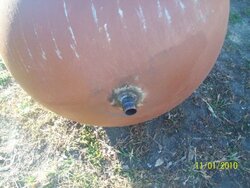Just thought I'd pass on my experience real quick.
My welder just left my place after coming out to fix 3 welds (out of 11) that had leaks. He had one of his guys (who is certified) do them the first time, as he was really busy (they are an ASME shop). One of the welds was a tiny pinhole on a small hole that he drilled in the wrong place by mistake then had to weld over. That one was on him. But the other two (an elbow & a plug) were due to me somehow getting hold of cast iron fittings. I picked them out of the black iron bins at the supplier (they sell a lot of stuff to the trades), and they even seemed to have the proper UL BI markings on them (I think). They looked everything like BI, but they were cast. He could show me the difference touching with his grinder on a couple of good ones. He also took responsibility for that, in that they're supposed to double check the fittings before they weld them on to make sure they are what they're supposed to be - just that his guy didn't take that extra step due to squeezing me in when they could & the busy-ness. Everything worked out in the end, I now have solid tanks and we're all good - but I'd advise to limit the welding to the absolute minimum required, and triple check that the fittings you buy are what they seem to be. I can't describe how to tell the difference, but you can with a grinder & the way they spark. That doesn't help in a store, but if they turn out to be cast, you could likely take them back if checked before welded. All fittings I got are made in China, and they seem to have the same markings - but there are small differences in them if you look real close, like in the size & fonts of the markings, & their orientations.
My welder just left my place after coming out to fix 3 welds (out of 11) that had leaks. He had one of his guys (who is certified) do them the first time, as he was really busy (they are an ASME shop). One of the welds was a tiny pinhole on a small hole that he drilled in the wrong place by mistake then had to weld over. That one was on him. But the other two (an elbow & a plug) were due to me somehow getting hold of cast iron fittings. I picked them out of the black iron bins at the supplier (they sell a lot of stuff to the trades), and they even seemed to have the proper UL BI markings on them (I think). They looked everything like BI, but they were cast. He could show me the difference touching with his grinder on a couple of good ones. He also took responsibility for that, in that they're supposed to double check the fittings before they weld them on to make sure they are what they're supposed to be - just that his guy didn't take that extra step due to squeezing me in when they could & the busy-ness. Everything worked out in the end, I now have solid tanks and we're all good - but I'd advise to limit the welding to the absolute minimum required, and triple check that the fittings you buy are what they seem to be. I can't describe how to tell the difference, but you can with a grinder & the way they spark. That doesn't help in a store, but if they turn out to be cast, you could likely take them back if checked before welded. All fittings I got are made in China, and they seem to have the same markings - but there are small differences in them if you look real close, like in the size & fonts of the markings, & their orientations.


